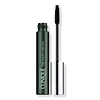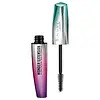What's inside
What's inside
 Key Ingredients
Key Ingredients

 Benefits
Benefits

 Concerns
Concerns

 Ingredients Side-by-side
Ingredients Side-by-side

Water
Skin ConditioningCopernicia Cerifera Wax
Stearic Acid
CleansingGlyceryl Stearate
EmollientPolyisobutene
Silica
AbrasiveAcrylates Copolymer
Aminomethyl Propanediol
BufferingVp/Eicosene Copolymer
Sodium Hyaluronate
HumectantLauroyl Lysine
Skin ConditioningPantethine
EmollientMelanin
Skin ProtectingPanthenol
Skin ConditioningEthylhexylglycerin
Skin ConditioningHydroxyethylcellulose
Emulsion StabilisingCalcium Aluminum Borosilicate
Pvp
Emulsion StabilisingAcacia Senegal Gum
MaskingIsostearic Acid
CleansingSimethicone
EmollientDimethicone PEG-8 Polyacrylate
Urea
BufferingGlycerin
HumectantPentaerythrityl Tetra-Di-T-Butyl Hydroxyhydrocinnamate
AntioxidantSodium Lauryl Sulfate
CleansingPEG-8 Dimethicone
EmulsifyingDisodium EDTA
Sorbic Acid
PreservativeChlorphenesin
AntimicrobialSodium Dehydroacetate
PreservativePhenoxyethanol
PreservativeMica
Cosmetic ColorantCI 77491
Cosmetic ColorantCI 77492
Cosmetic ColorantCI 77499
Cosmetic ColorantCI 77400
Cosmetic ColorantCI 42090
Cosmetic ColorantCI 77891
Cosmetic ColorantCI 19140
Cosmetic ColorantCI 77288
Cosmetic ColorantCI 77289
Cosmetic ColorantCI 75470
Cosmetic ColorantCI 77163
Cosmetic ColorantCI 77007
Cosmetic ColorantCI 77000
Cosmetic ColorantWater, Copernicia Cerifera Wax, Stearic Acid, Glyceryl Stearate, Polyisobutene, Silica, Acrylates Copolymer, Aminomethyl Propanediol, Vp/Eicosene Copolymer, Sodium Hyaluronate, Lauroyl Lysine, Pantethine, Melanin, Panthenol, Ethylhexylglycerin, Hydroxyethylcellulose, Calcium Aluminum Borosilicate, Pvp, Acacia Senegal Gum, Isostearic Acid, Simethicone, Dimethicone PEG-8 Polyacrylate, Urea, Glycerin, Pentaerythrityl Tetra-Di-T-Butyl Hydroxyhydrocinnamate, Sodium Lauryl Sulfate, PEG-8 Dimethicone, Disodium EDTA, Sorbic Acid, Chlorphenesin, Sodium Dehydroacetate, Phenoxyethanol, Mica, CI 77491, CI 77492, CI 77499, CI 77400, CI 42090, CI 77891, CI 19140, CI 77288, CI 77289, CI 75470, CI 77163, CI 77007, CI 77000
Water
Skin ConditioningGlyceryl Stearate
EmollientParaffin
PerfumingPropylene Glycol
HumectantPvp
Emulsion StabilisingCopernicia Cerifera Cera
EmollientStearic Acid
CleansingVp/Eicosene Copolymer
Polysorbate 20
EmulsifyingArginine
MaskingCera Alba
EmollientCaprylic/Capric Triglyceride
MaskingAmmonium Acrylates Copolymer
Hydroxyethylcellulose
Emulsion StabilisingPhenoxyethanol
PreservativePanthenol
Skin ConditioningLauroyl Lysine
Skin ConditioningRicinus Communis Seed Oil
MaskingBis-Stearyl Dimethicone
EmollientSodium Polyacrylate
AbsorbentNylon-6/12
AbsorbentTocopheryl Acetate
AntioxidantNylon-6
Ethylene/Acrylic Acid Copolymer
Emulsion StabilisingAlcohol Denat.
AntimicrobialStyrene/Acrylates Copolymer
Cellulose
AbsorbentDisodium EDTA
Disodium Deceth-6 Sulfosuccinate
CleansingEthylhexylglycerin
Skin ConditioningStearalkonium Hectorite
Gel FormingLaureth-30
CleansingC11-15 Pareth-40
CleansingC11-15 Pareth-7
EmulsifyingPropylene Carbonate
SolventPantolactone
HumectantSodium Dehydroacetate
PreservativeCaprylyl Glycol
EmollientSodium Laureth-12 Sulfate
CleansingDisodium Phosphate
BufferingPolysorbate 60
EmulsifyingSilica
AbrasiveTocopherol
AntioxidantSodium Phosphate
BufferingTriethoxycaprylylsilane
Water, Glyceryl Stearate, Paraffin, Propylene Glycol, Pvp, Copernicia Cerifera Cera, Stearic Acid, Vp/Eicosene Copolymer, Polysorbate 20, Arginine, Cera Alba, Caprylic/Capric Triglyceride, Ammonium Acrylates Copolymer, Hydroxyethylcellulose, Phenoxyethanol, Panthenol, Lauroyl Lysine, Ricinus Communis Seed Oil, Bis-Stearyl Dimethicone, Sodium Polyacrylate, Nylon-6/12, Tocopheryl Acetate, Nylon-6, Ethylene/Acrylic Acid Copolymer, Alcohol Denat., Styrene/Acrylates Copolymer, Cellulose, Disodium EDTA, Disodium Deceth-6 Sulfosuccinate, Ethylhexylglycerin, Stearalkonium Hectorite, Laureth-30, C11-15 Pareth-40, C11-15 Pareth-7, Propylene Carbonate, Pantolactone, Sodium Dehydroacetate, Caprylyl Glycol, Sodium Laureth-12 Sulfate, Disodium Phosphate, Polysorbate 60, Silica, Tocopherol, Sodium Phosphate, Triethoxycaprylylsilane
Ingredients Explained
These ingredients are found in both products.
Ingredients higher up in an ingredient list are typically present in a larger amount.
Disodium EDTA plays a role in making products more stable by aiding other preservatives.
It is a chelating agent, meaning it neutralizes metal ions that may be found in a product.
Disodium EDTA is a salt of edetic acid and is found to be safe in cosmetic ingredients.
Learn more about Disodium EDTAEthylhexylglycerin (we can't pronounce this either) is commonly used as a preservative and skin softener. It is derived from glyceryl.
You might see Ethylhexylglycerin often paired with other preservatives such as phenoxyethanol. Ethylhexylglycerin has been found to increase the effectiveness of these other preservatives.
Glyceryl Stearate is a mix of glycerin and stearic acid.
It is used to stabilize the mixing of water and oil ingredients. By preventing these ingredients from separating, it can help elongate shelf life. It can also help thicken the product's texture.
As an emollient, it helps soften skin and supports barrier-replenishing ingredients.
In cosmetics, Glyceryl Stearate is often made from vegetable oils or synthetically produced.
This ingredient may not be fungal-acne safe
Fun fact: The human body also creates Glyceryl Stearate naturally.
Learn more about Glyceryl StearateHydroxyethylcellulose is used to improve the texture of products. It is created from a chemical reaction involving ethylene oxide and alkali-cellulose. Cellulose is a sugar found in plant cell walls and help give plants structure.
This ingredient helps stabilize products by preventing ingredients from separating. It can also help thicken the texture of a product.
This ingredient can also be found in pill medicines to help our bodies digest other ingredients.
Learn more about HydroxyethylcelluloseThis ingredient comes from a fatty acid (lauric acid) and amino acid (lysine). It is used to add a silky feel to cosmetics.
According to a manufacturer, its fatty acid base leaves a silky feeling on the skin. It also has emollient properties because of this. Emollients help soften skin by preventing water from evaporating.
Lauroyl lysine is barely soluble in water.
Learn more about Lauroyl LysinePanthenol is a common ingredient that helps hydrate and soothe the skin. It is found naturally in our skin and hair.
There are two forms of panthenol: D and L.
D-panthenol is also known as dexpanthenol. Most cosmetics use dexpanthenol or a mixture of D and L-panthenol.
Panthenol is famous due to its ability to go deeper into the skin's layers. Using this ingredient has numerous pros (and no cons):
Like hyaluronic acid, panthenol is a humectant. Humectants are able to bind and hold large amounts of water to keep skin hydrated.
This ingredient works well for wound healing. It works by increasing tissue in the wound and helps close open wounds.
Once oxidized, panthenol converts to pantothenic acid. Panthothenic acid is found in all living cells.
This ingredient is also referred to as pro-vitamin B5.
Learn more about PanthenolPhenoxyethanol is a preservative that has germicide, antimicrobial, and aromatic properties. Studies show that phenoxyethanol can prevent microbial growth. By itself, it has a scent that is similar to that of a rose.
It's often used in formulations along with Caprylyl Glycol to preserve the shelf life of products.
Pvp is a water-soluble synthetic polymer and common hairstyling ingredient. It is a film-forming ingredient and used to "hold" specific shapes of hair.
Pvp is less effective in high-humidity. It tends to draw moisture, but this moisture dismantles the structure and "hold".
Silica, also known as silicon dioxide, is a naturally occurring mineral. It is used as a fine, spherical, and porous powder in cosmetics.
Though it has exfoliant properties, the function of silica varies depending on the product.
The unique structure of silica enhances the spreadability and adds smoothness, making it a great texture enhancer.
It is also used as an active carrier, emulsifier, and mattifier due to its ability to absorb excess oil.
In some products, tiny microneedles called spicules are made from silica or hydrolyzed sponge. When you rub them in, they lightly polish away dead skin layers and enhance the penetration of active ingredients.
Learn more about SilicaThis ingredient is a preservative with antimicrobial properties. It is the sodium salt of dehydroacetic acid.
It is especially effective at preventing bacterial and fungal growth in low concentrations.
Stearic Acid is a fatty acid. It is an emollient, emulsifier, and texture enhancer.
As an emollient, stearic acid helps soften skin. It aids the skin's protective barrier by preventing water loss. It also provides a gentle cleansing effect without stripping away natural oils.
Stearic acid may also be used to enhance the texture of products. It can add volume and stabilize ingredients such as water and oil. This can help water and oil ingredients from separating.
Sources of stearic acid include animal or vegetable fats/oils such as coconut or shea. It can be naturally found in butter, cocoa butter, shea butter, vegetable fats, and animal tallow.
This ingredient may not be Malassezia folliculitis, or fungal-acne safe.
Learn more about Stearic AcidWe don't have a description for Vp/Eicosene Copolymer yet.
Water. It's the most common cosmetic ingredient of all. You'll usually see it at the top of ingredient lists, meaning that it makes up the largest part of the product.
So why is it so popular? Water most often acts as a solvent - this means that it helps dissolve other ingredients into the formulation.
You'll also recognize water as that liquid we all need to stay alive. If you see this, drink a glass of water. Stay hydrated!
Learn more about Water